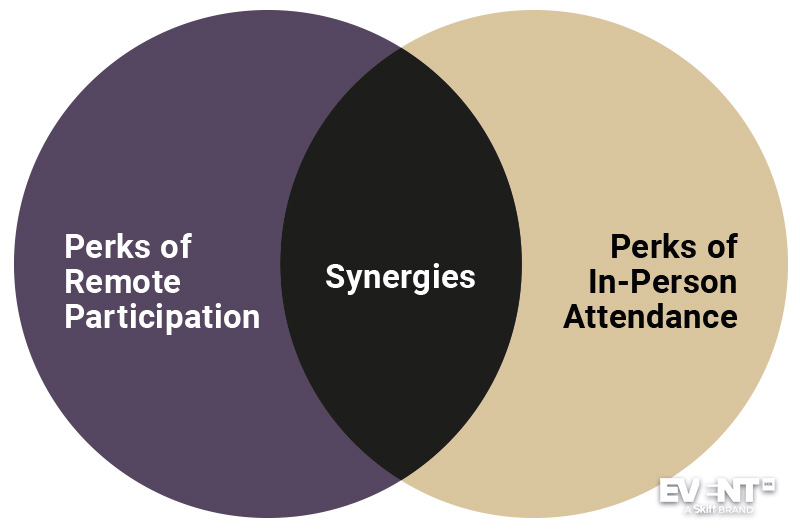Skift Take
Hybrid events require planners to attract in-person attendees without alienating virtual attendees, and to compete for the attention of a virtual audience in a saturated market. How can planners market their events to stand out and appeal to both groups?
Event planners now face a new challenge: Their virtual offerings need to be compelling enough to draw a remote audience that currently faces a surplus in choice, but not so compelling as to remove the incentive to attend in person.
In-person attendance and remote participation come with their own distinct advantages, and the trick is to frame your marketing in terms of what is best about each—not in terms of why one is better than the other. At the same time, planners need to think about the ways that these two spheres can overlap to create unique synergies.

6 Strategies to Overcome Marketing Barriers for Hybrid Events
Ideally, the event’s marketing efforts should integrate seamlessly with its hybrid format. The event’s content should shape the marketing, and the marketing should help to prepare the audience for all aspects of the event.
Hybrid events have an added layer of complexity because they need to consider how the live and virtual experiences function both as independent components and as interdependent parts.
Leading up to the event, the marketing campaign should emphasize:
- the flexibility and accessibility offered by virtual participation
- the immersive experience that comes with in-person attendance
- the possibility for two-way interaction between live attendees and remote participants
Host an Event Teaser to Familiarize Attendees with the Virtual Event Platform
One of the advantages of an online format is that it provides many opportunities for pre-event engagement.
For example, a teaser livestream broadcast can allow prospective attendees to preview the event’s content while showcasing the engagement and interactivity your platform offers. This gives prospective virtual attendees a chance to explore the online format ahead of time, and even those planning to attend in person will have an incentive to become familiar with the platform beforehand.
Offer Audio-Only Content to Bypass Zoom Fatigue
Format matters as much for the teaser event as it does for the main attraction, and there are three interrelated aspects of the virtual experience that account for most of its appeal: convenience, flexibility, and accessibility.
This doesn’t always mean that more is better. Many potential participants may be experiencing ‘Zoom fatigue’ — tired of both being watched and watching others on a screen — and some may prefer engaging through audio only. While it’s still a good idea to offer video content and some more interactive features like Q&A, it’s wise to design some sessions that will work equally well as podcasts. Online engagement is all about choice, with the option to jump between the minimal focus demanded by background audio to the maximal engagement facilitated by active comment strings and live polls.
Position Smaller Events as Exclusive Rather than Limited
In some ways, the elements that make a live experience attractive are the exact opposite: It is about being fully present and immersed in the multi-sensory experience. When marketing the live experience, planners need to think about the unique experiences that make being there physically worth it.
With the exception of cities like Vegas or Miami, chances are that any live event component is going to be limited to a small group of socially distanced professionals. Prospective attendees might see this as a downside. What is the networking potential of an event with 10, 20, or 45 people compared to the hundreds they might be used to?
But smaller crowds mean that it is often easier to craft unique experiences that will drive ticket sales while also grabbing the attention of remote participants.
Combat the sentiment that your live event is limited by concentrating on event design, and emphasize the experience aspect in your communications. Focus on creating a sense of luxury, novelty, or unique opportunity.
Use the Event Destination to Make the In-Person Experience Worthwhile
Because attendees can now tune into events anywhere in the world through virtual participation, planners need to think about how to make their event destination stand out from all the rest.
To promote in-person attendance and optimize cross-promotional opportunities, consider hosting a pre-event interview on location with an influencer—ideally one who will be speaking at the event itself.
Influencers attending the event can also help to promote the unique value propositions of the destination. This approach can enhance the impression that the event is designed as an exclusive experience for a limited number of attendees.
In his interview for the Hybrid Event Revolution, Shawn Cheng recommended thinking about ways to maximize the appeal of the event’s destination by organizing tours of nearby attractions. Another speaker at the event, film festival director Meschida Philip explained how she was able to stage one of her hybrid festival’s concerts beside a waterfall — a setting that would not be possible with a larger in-person audience. An immersive, memorable experience like this one will be an enticement for both live attendees and those tuning in from home.
Leverage Hybrid Interaction to Reassure Prospective Attendees
The interaction between in-person and virtual audiences should factor into the event’s marketing, and a small in-person audience at a teaser event could demonstrate this dynamic in action.
When speaking at the Hybrid Event Revolution, MCI’s Shawn Cheng even compared planning hybrid events to staging reality TV shows. He suggested making the audience part of the show, with cameras recording their reactions. Unlike remote Zoom participants who might feel worn out by having to remember that they are continually being recorded, in-person attendees might feel a slight thrill from momentarily being in the spotlight when their reaction is recorded by chance. Meanwhile, remote participants will feel more connected.
Another speaker, MeetingPlay Founder Joe Schwinger, recommended setting up an ‘ambassador’ system whereby live attendees would be matched with a group of remote participants. Taking on the role of an influencer, the in-person ambassador would volunteer to share highlights from the event and answer questions.
Use Social Media to Build an Online Community for Ongoing Engagement
There is an adage in business that recommends the economic efficiency of retaining customers over gaining new ones, and with much of the event content being experienced virtually as events begin to recover, event planners should think about the implications on their relationships with their audience. Particularly when Covid is limiting realistic events in many cases to a single day, what is the utility of keeping your audience engagement limited to the event?
As more event content is offered for consumption on demand, at people’s leisure, more of the opportunity for engagement with the content and your audience will take place outside of the event itself. It has always been a good idea to have a social media presence for your event, but the sort of branding planners should be thinking of when creating communities around recurring events should be geared to the long term: Dedicated event Facebook groups, hashtags that are kept alive and in circulation, Instagram accounts that show behind-the-scenes of event production and spotlight both speakers and influencers as well as particularly active members of the community with interesting things to say.
Creating a social media community around your event and its brand will supply future iterations of the event, spin-offs, and the organizers’ other endeavours more generally with a ready and waiting audience.
The hybrid format also presents new channels for building an online community in the lead up to the event. To return to Schwinger’s advice, for example, if ambassadors and followers are matched ahead of time, they will have the chance to form a community and build excitement.
As a final strategy, professionally designed social media posts can help to generate buzz online while also reinforcing the event’s branding. Ideally, in-person attendees and remote participants should be actively interacting with one another online even before the event begins.
IN CONCLUSION
Hybrid events present a marketing challenge, but they also provide an opportunity for innovation that translates to unique selling points. The trick is not just to bring out the best in each format individually, but to optimize how they work together.





